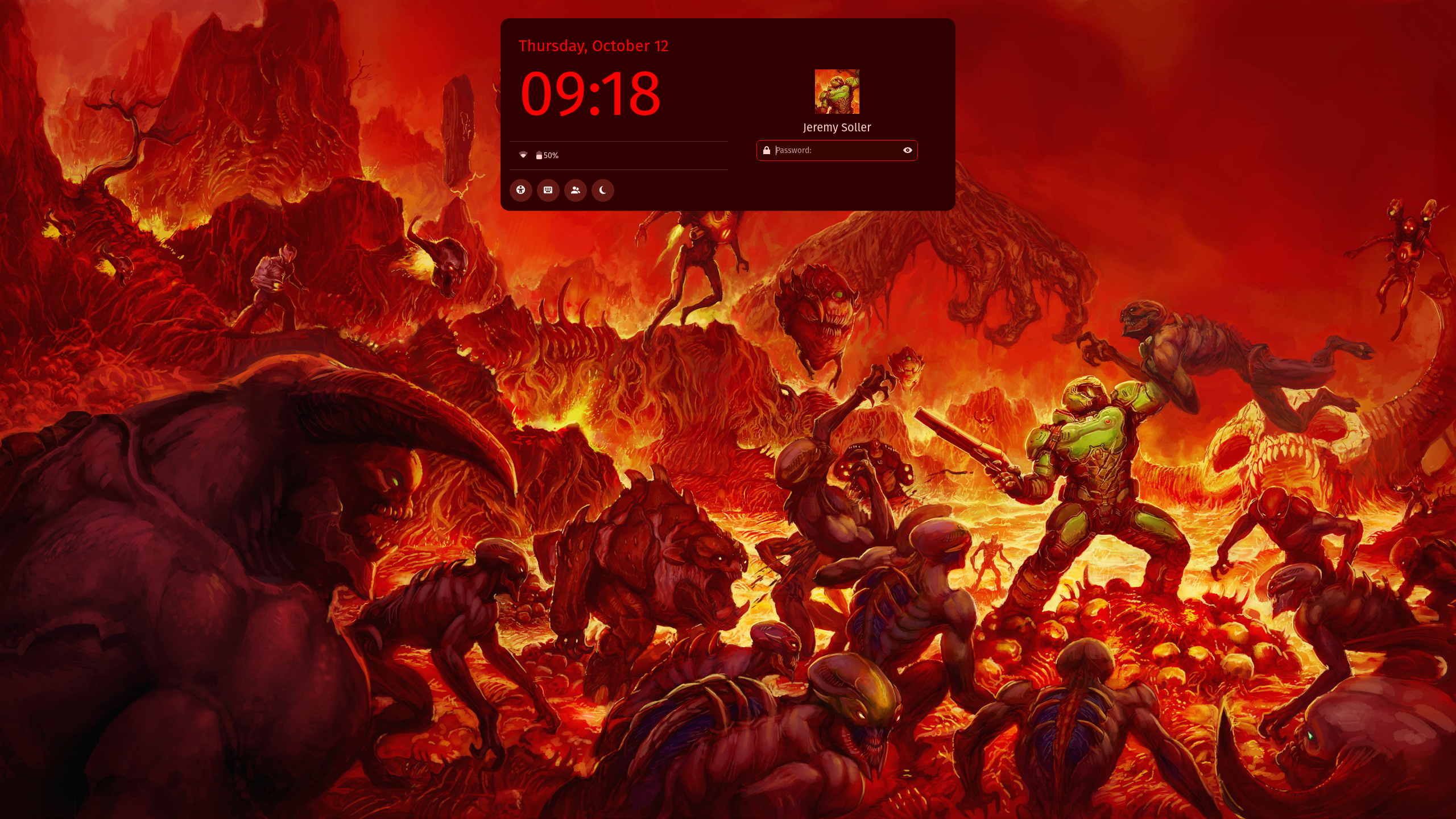cross-posted from: https://lemmy.ndlug.org/post/280126
Jeremy Soller shares some examples of the COSMIC lock screen that Pop!_OS is working on.
Bruh COSMIC is looking unbelievable. I can’t wait to see it in action. Is it still on track for 1.0 before the end of the year?
Man that’s so exciting, I despise how boring the gnome lock screen is. The default gray background just looks so bland.
I can’t wait for Cosmic. I might even make the switch when it hits alpha, I’ve had quite enough of Gnome lately.
Brilliant work! COSMIC is a breath of fresh air for the Linux desktop community.
two questions:
-
Is COSMIC DE going to be exclusively Wayland? Would make sense but I’m just curious.
-
will COSMIC DE be available separately from Pop!OS? I think this could be a very popular choice for people getting into Arch or Nix, for example.
- Yes
- That depends on those other distributions willingness to package it for their distributions.
Brilliant!
Hoping someone packages it for gentoo 🤞
-
Is the DE still reliant on GTK? Will there be thumbnails in the filepicker?
The DE is not reliant on Gtk, it uses Iced, which is fully written in Rust. And the Gtk file picker also has thumbnails now.
Have the cosmic devs said if their file picker portal will support thumbnails?
They haven’t created the file chooser portals yet. But I saw a comment from mmstick a few months ago on reddit that he said it will support it. I mean it’s a simple basic- feature, gnome could’ve had it if they cared.
Gnome has it now! It only took 20 years which makes it so much better to see it in action. Thanks to the person who made that contribution!
We have been developing our own toolkit, libcosmic, which is being used for everything. From the lock screen, compositor, applets for the desktop, and the applications themselves. There is an examples directory for third party developers to learn hope to build their own applets and applications with.
Which display manager do you guys plan to use?
You’re looking at it.
This is interesting. I’m a window manager user, but currently, the Wayland Display Managers suck. I’m using sddm but I don’t like it.
I’m guessing that this one will be modular enough to be installed without the whole Cosmic DE? It seems interesting.
The
cosmic-greeterpackage is already installable today. It will work on any system that hasgreetdavailable. The Appearance panel in COSMIC Settings is not yet merged, but it is in theappearancestaging branch.Tbh, cosmic-epoch itself is kinda modular, yet slightly weird. I used it on nixos for a short while (until some shit in nix changed, and pop’s flakes decided to not compile) recently.
The strangest thing is their way to store configuration: cosmic-comp (I.e. their compositor) has 2. The 1st is a “regular” file (.ron, as far as I remember) and is used to store keybindings and some other settings (for example whether to tile windows automatically, border width, etc), and the second one is like windows’s registry on top of the filesystem (I.e. you have
~/.config/cosmic/com.system76.whatever/dir0/file0wheredir0represents some group of parameters (?) andfile0is the name of one; the value is the contents offile0. Easily manageable with nix but confusing AF to edit manually. Most if not all except the compositor uses the latter format.On the other hand, the compositor is already quite cool with regards to animations and window/workpace movement at least, and is reasonably stable for a pre-alpha. Also, their way to make bars seems interesting: each applet itself is a graphical app using xdg-shell, and the panel uses pop’s lib to “convert” them to layer-shell.
The only thing I am kind of skeptical about Cosmic is how it will handle other apps like KDE or GNOME apps, especially the Libadwaita ones. I have one question, will it be possible to kind of make them fit in the system or the other way around, make the system look like it has a libadwaita look? I just really love some consistency
The desktop environment doesn’t control how applications look or function. Regarding theming, GTK3 applications need a GTK3 theme, GTK4 applications need a GTK4 theme, libadwaita applications need a libadwaita theme, and KDE applications need a KDE theme. Our tooling for generating themes will attempt to generate themes for other toolkits, but COSMIC applications have a different design language than GNOME or KDE applications.
That is the answer I was looking for, thanks so much for clarifying!
I love the new lockscreen. Looks great so far.
I’ve got some concerns about the screen space usage for the desktop itself however. Between the top “Gnome” bar and the bottom panel for apps, that’s a lot of vertical space used up. I can imagine this being awful for small screen laptops. Gnome doesn’t have this issue because the bottom “dock” is hidden until the actitives button is pressed. Will Cosmic in some way allow the user to hide or move the bottom panel?
The dock is hidden by default and appears when pressure is applied. It is also optional. Was that the only concern?
deleted by creator
Awesome! Yeah, that’s what I was a bit apprehensive about. I’ve only seen screenshots of a blank desktop so far, and they always show the dock. And the “apply pressure” method is definitely the better way to go.
I completely missed that system76 launched COSMIC already lol
I don’t think they did?
It isn’t released yet but you can compile it yourself as the source code is available
Looks great! I can’t wait, cosmic is already my favorite out of the box DE by a long shot
How do you run it? I admit I haven’t dug too deep, but I haven’t seen a release post. I’ve only seen Dev blog posts about the work being done.
Here are instructions for installing the current state of Cosmic https://m.youtube.com/watch?v=3ZCCVRbYYRM
It is in a very pre-alpha state. The promoted demonstrations are being made by people developing Cosmic, so have a deep knowledge of how to configure it manually, or are using features that haven’t been merged into the currently distributed package.
Apparently, some people that work at System76 are daily driving Cosmic, but they must be using a different configuration than what is part of the shipped package. As is, I find it basically a demo that is functional enough to attempt using for more than 5 minutes, but giving up not long after.
Here is an alternative Piped link(s):
https://m.piped.video/watch?v=3ZCCVRbYYRM
Piped is a privacy-respecting open-source alternative frontend to YouTube.
I’m open-source; check me out at GitHub.
Thank you, unfortunate it is a video but at least there’s something. I feel like my requirements of a DE are pretty low, so if it does work, and can open a window with AMD GPU acceleration then cool. I’m not fully aware of how much I actually use specific DE features, so this would be a good way to find out haha. I’d love to give it a shot on NixOS.
I’m just talking about cosmic gnome hahaha. I’m not running the rust version
Recently moved to PopOS and while I’ve been generally aware of Cosmic I’ve been looking into it a lot recently, don’t know much about programming languages but from what I understand Rust is supposed to be really fast for this stuff.
Will using Rust cause the desktop to feel really responsive/snappy compared to other ones like Gnome or KDE Plasma (not that they’re slow), or is it more like an efficiency thing, less CPU/RAM use, etc? If this has already been answered can someone link me because I haven’t been able to find much on it
Rust wouldn’t necessarily make it more responsive. It is more oriented towards safety and robustness.
Cosmic might be more responsive / efficient due to the fact that it’s a new development and they can choose to implement things better and not carry old baggage, but that’s about it. Rust doesn’t have much say in it.
Edit: Although, if they are moving away from JavaScript in Gnome as their shell language to pure Rust in Cosmic, then you would probably see some responsiveness / efficiency gains, yes.
Synthetic benchmarks written in Rust are as fast as those in C. In practice, Rust applications are more efficient than their C counterparts. The performance and efficiency is nice, but the main benefit will be stable software that is free of vulnerabilities caused by common mistakes in C and C++. Virtually every Curl vulnerability would not happen in Rust.
There’s half of a century of programming language theory research between C++ and Rust. Which solves many of the issues in programming that are common in C and C++. Such as the memory and thread safety violations that can be difficult to diagnose, application crashes, and critical software vulnerabilities.
The language concepts and compiler features also prevent a lot of common logical mistakes a programmer may make. Such that the best practices in C++ are the baseline for any Rust project that successfully compiles. It is easy to develop highly parallel and asynchronous software that just works and is easy to maintain and debug. As a result, you may notice Rust projects developing to maturity much quicker than you’d expect.













